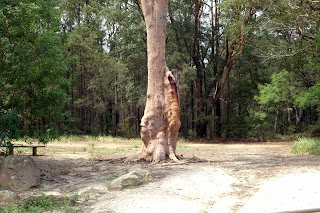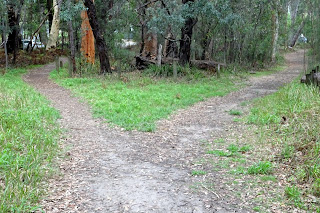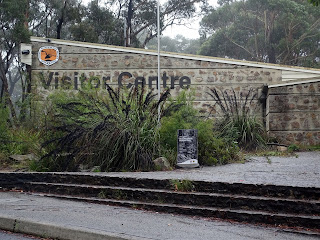Glenbrook Lagoon
On Wednesday 29th January, after lunch, we drove down to Glenbrook Lagoon, as we wanted to photograph some of the Wetland birds. It was a very hot afternoon and there weren't many birds about, except for a few ducks. I guess it must have been too hot for most of the birds and they were probably resting in the nearby trees. Perhaps, if we had been there in the evening we would have seen quite a few. It was even too hot for us to do our usual walk, through the bush, around the Lagoon, so we left quite disappointed. We decided to return in the cooler weather. We know that January is not a good month to do bushwalks, but we thought being near water it might have been cooler.
We saw this Robinson Crusoe style of raft floating in the water near a sandy bank. It looks as though some children, might had some recent holiday fun with it!
Looking across the Lagoon from a sandy shore. The day was overcast, which led us to believe it might have been cooler than what it actually was. It was also very humid.
A Pacific Black Duck dabbling on the water of the Lagoon. Even though the duck is predominantly brown, it is still called a Pacific Black Duck. There weren't many other birds around, although Ken did see a Purple Swamphen.
All the trees were shedding their bark and revealing the most beautiful colours on their trunks. This one looked as though it had a giant lizard about to climb its trunk!
A fork in the pathway, one leading back to the car park and the other to the road. The grass was even green, after the recent rain.
Glenbrook Lagoon is a heritage listed site located at Glenbrook in the Blue Mountains. The Lagoon is a natural flat bottom freshwater Lagoon with an average depth of 2.7 metres and a maximum depth of 4.05 metres. The Lagoon covers an area of 7 hectares and is fed by natural springs and also Lapstone Creek. The Lagoon and its surrounding bushland provides an important natural sanctuary for native flora and fauna and is currently a nature reserve and area for Wetland birds.
Thursday, 30 January 2020
Tuesday, 21 January 2020
Blackheath
Trip to Govetts Leap
Last weekend, Diane and David were staying with us and on Sunday we took a drive up the Mountains, hoping to show our guests some of the scenic wonder of the Blue Mountains. The weather was not the best for sight-seeing as it was raining lightly, with mist descending and the further we drove up the Mountains, the mistier it became. We were not complaining, as our drought ravaged country desperately needs rain. We decided to head for Govetts Leap in Blackheath to see the extent of the recent bushfire damage.
We were able to drive into the car park at Govetts Leap in the Blue Mountains National Park, as it had just re-opened that day, after being closed since Christmas. The extent of the damage is horrific. It was still raining and a heavy mist hung over the Grose Valley, so our view from the lookout was completely obscured. Through the mist we could distinguish the outline of burnt and charred trees where the fire had raced up the escarpments from the valley below. The fire had come right up to the lookout itself and also the surrounding bushland around the car park. The mist contributed to the feeling of smoke still lingering in the air.
At the Lookout, we looked down on burnt trees and black and smouldering ground, completely stripped of any plant life, by the fire. It was terrible to see this normally beautiful area in such a state of ruin!
Looking out in the rain and mist, surveying the damage to the bush. The beautiful view normally visible from this Lookout was completely veiled by mist. I shudder to think what that view would look like now!
The obelisk at the Lookout states that Govetts Leap was named after William Govett, a painter and surveyor and also the first European settler to have visited this area. According to the sign he first discovered this beautiful spot in June, 1831.
The bushfire raced up the escarpments from the valley floor below, destroying all the undergrowth in its' path and burning all the trees. The smell of smoke still lingered in the air.
The entrance to the Cliff Top Walking Track was closed, too dangerous still to make a trek through the bush to Evans Lookout.
This tree is unrecognisable, with its burnt fronds hanging limply down. It looks like a tree fern. Hopefully, it will reshoot and recover. Most indigenous trees and plants have adapted to withstand the onslaught of bushfires and do resprout and grow again.
The Visitor Centre, near Govetts Leap Lookout, was fortunately saved from the flames by the dedicated work of the volunteer RFS firefighters. However, it is surrounded by burnt bushes right up to the front door of the Centre, evidence of how close the fire came to destroying the building!
We went inside the Centre, which was open for business. It is well stocked with maps and tourist information for the visitors, as well as souvenirs, books and other items for sale. We then saw a little film in the cinema room about the plants and wildlife in the Grose Valley and I just hope that in time the Valley is able to recover.
We then departed for lunch up in the township of Blackheath and a wander around the shops and antique stores, spending some money to help boost the economy, as this little township desperately needs all the tourist dollars it can get.
Last weekend, Diane and David were staying with us and on Sunday we took a drive up the Mountains, hoping to show our guests some of the scenic wonder of the Blue Mountains. The weather was not the best for sight-seeing as it was raining lightly, with mist descending and the further we drove up the Mountains, the mistier it became. We were not complaining, as our drought ravaged country desperately needs rain. We decided to head for Govetts Leap in Blackheath to see the extent of the recent bushfire damage.
We were able to drive into the car park at Govetts Leap in the Blue Mountains National Park, as it had just re-opened that day, after being closed since Christmas. The extent of the damage is horrific. It was still raining and a heavy mist hung over the Grose Valley, so our view from the lookout was completely obscured. Through the mist we could distinguish the outline of burnt and charred trees where the fire had raced up the escarpments from the valley below. The fire had come right up to the lookout itself and also the surrounding bushland around the car park. The mist contributed to the feeling of smoke still lingering in the air.
At the Lookout, we looked down on burnt trees and black and smouldering ground, completely stripped of any plant life, by the fire. It was terrible to see this normally beautiful area in such a state of ruin!
Looking out in the rain and mist, surveying the damage to the bush. The beautiful view normally visible from this Lookout was completely veiled by mist. I shudder to think what that view would look like now!
The obelisk at the Lookout states that Govetts Leap was named after William Govett, a painter and surveyor and also the first European settler to have visited this area. According to the sign he first discovered this beautiful spot in June, 1831.
The bushfire raced up the escarpments from the valley floor below, destroying all the undergrowth in its' path and burning all the trees. The smell of smoke still lingered in the air.
The entrance to the Cliff Top Walking Track was closed, too dangerous still to make a trek through the bush to Evans Lookout.
This tree is unrecognisable, with its burnt fronds hanging limply down. It looks like a tree fern. Hopefully, it will reshoot and recover. Most indigenous trees and plants have adapted to withstand the onslaught of bushfires and do resprout and grow again.
The Visitor Centre, near Govetts Leap Lookout, was fortunately saved from the flames by the dedicated work of the volunteer RFS firefighters. However, it is surrounded by burnt bushes right up to the front door of the Centre, evidence of how close the fire came to destroying the building!
We went inside the Centre, which was open for business. It is well stocked with maps and tourist information for the visitors, as well as souvenirs, books and other items for sale. We then saw a little film in the cinema room about the plants and wildlife in the Grose Valley and I just hope that in time the Valley is able to recover.
We then departed for lunch up in the township of Blackheath and a wander around the shops and antique stores, spending some money to help boost the economy, as this little township desperately needs all the tourist dollars it can get.
Subscribe to:
Posts (Atom)











